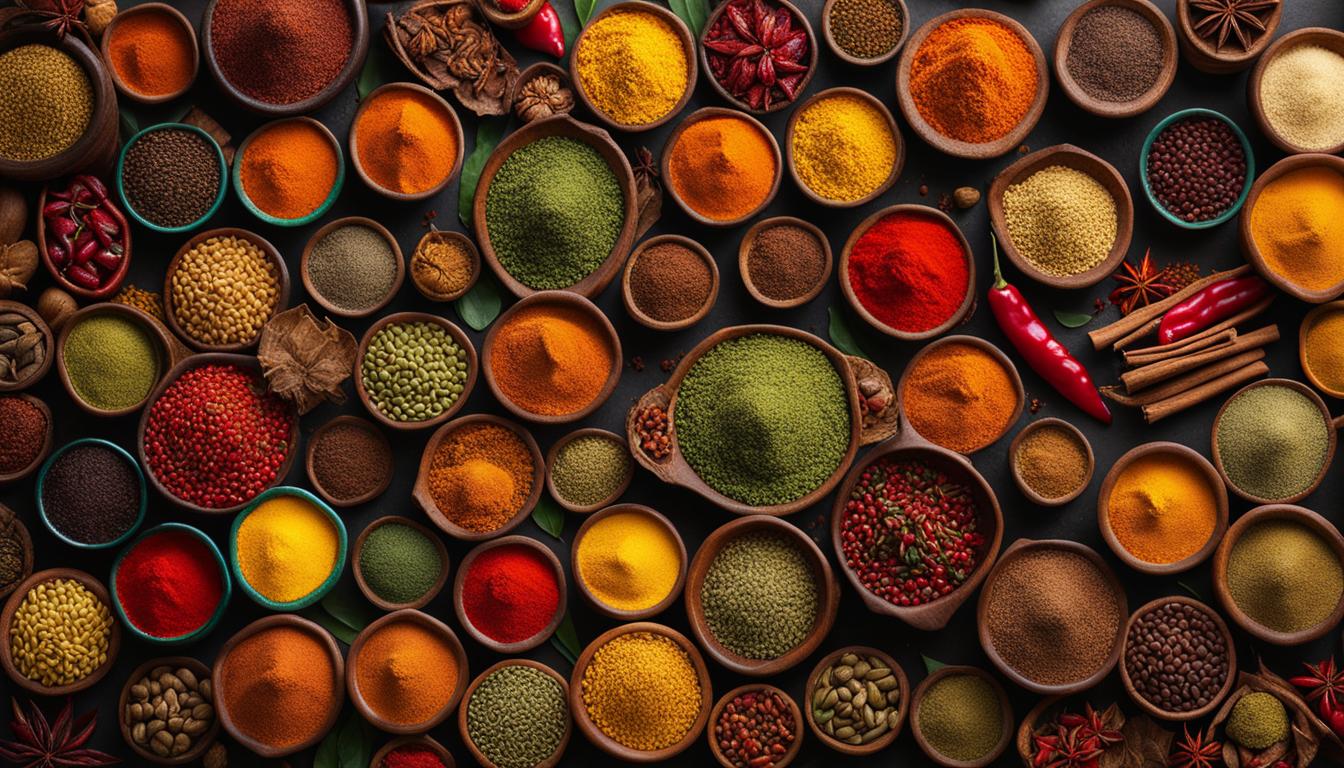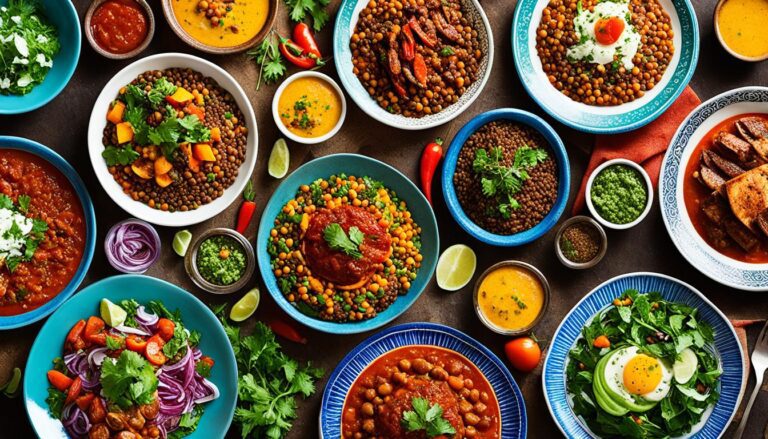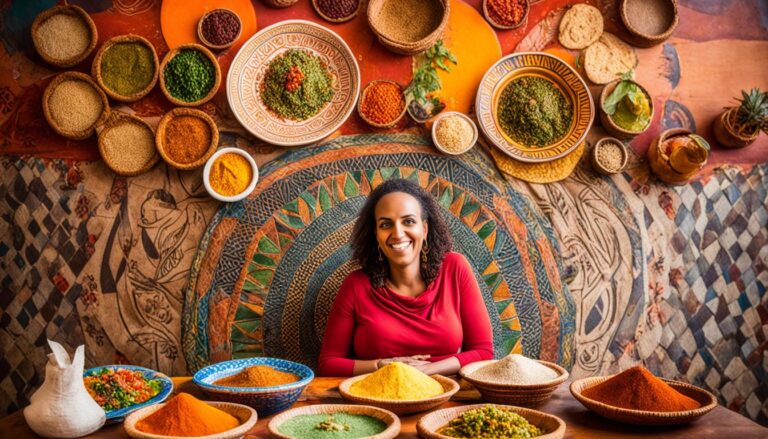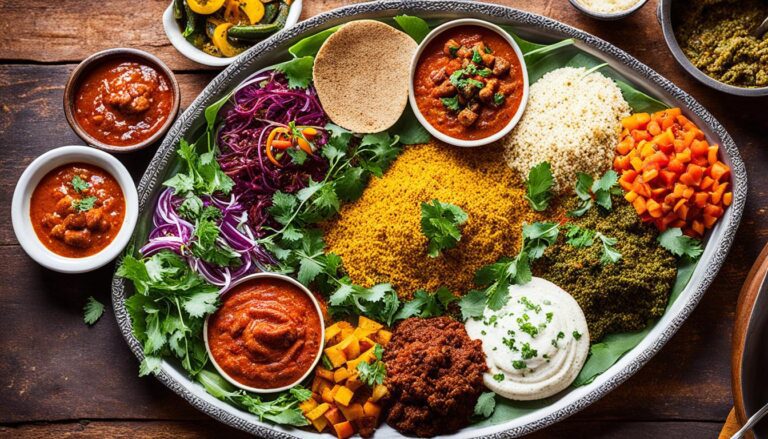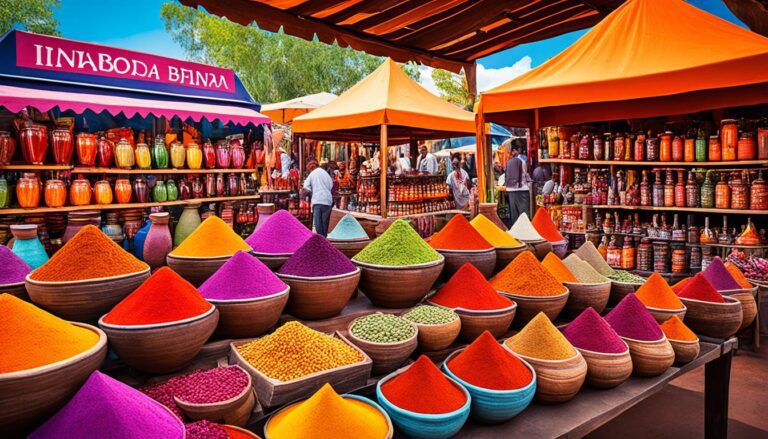Does Ethiopian Food Taste Like?
Welcome to our exploration of Ethiopian cuisine, where we immerse ourselves in the vibrant flavors and rich culinary traditions of this remarkable culture. Whether you’re a seasoned foodie or simply curious about global cuisines, prepare to embark on a taste adventure unlike any other.
But first, let’s address the burning question: Does Ethiopian food taste like? You may have preconceived notions or limited exposure to Ethiopian cuisine, but we’re here to challenge your beliefs and expand your gastronomic horizons.
Join us as we delve into the world of Ethiopian spices, iconic dishes, and the unique taste profiles that make this cuisine a standout on the global food map. Get ready to tantalize your taste buds and discover the answer to this intriguing query!
Key Takeaways:
- Ethiopian cuisine offers a diverse range of flavors and spices, combining to create a truly unique taste experience.
- Through this article, we will explore the essence of Ethiopian food and challenge your perceptions of its taste.
- Join us on this culinary journey filled with aromatic spices, traditional dishes, and mouthwatering flavors.
- Whether you’re a meat lover, vegetarian, or vegan, Ethiopian cuisine has something to offer everyone.
- Prepare to savor the heat and discover the distinct taste profiles that make Ethiopian food a culinary delight.
A Blend of Spices and Flavors
Ethiopian food is a true delight for the senses, offering a rich blend of aromatic spices and diverse flavors that tantalize the taste buds. The culinary traditions of Ethiopia are deeply rooted in the country’s history and culture, resulting in a unique gastronomic experience.
At the heart of Ethiopian cuisine are the vibrant and exotic spices that give each dish its distinct character. A medley of flavors such as berbere, a fiery spice blend, and mitmita, a hot chili pepper powder, infuse the food with an irresistible heat.
The flavors of Ethiopian food are unlike any other, combining elements of sweetness, tanginess, and spiciness in perfect harmony. Ethiopian spices are known for their depth and complexity, creating a symphony of flavors that dance on the palate.
One of the most popular Ethiopian spices is fenugreek, which imparts a unique aroma and earthy taste to dishes. Nigella seeds, commonly referred to as black cumin or onion seeds, add a subtle hint of bitterness and an intriguing texture.
Additionally, spices such as cardamom, cinnamon, and cloves add warmth and depth to the cuisine, elevating the flavors to new heights. Each spice has its own unique role in Ethiopian cooking, contributing to the overall complexity and richness of the dishes.
But it’s not just the spices that make Ethiopian food special. Traditional cooking techniques, such as slow simmering and stewing, further enhance the flavors and create tender, melt-in-your-mouth dishes.
Whether you’re savoring the tangy flavors of a zesty vegetable stew or indulging in the robust and aromatic taste of a meat dish, Ethiopian cuisine offers a culinary experience like no other.
In the next section, we will explore the staple bread of Ethiopian cuisine – Injera – and uncover its unique sour tang.
Injera – The Staple Bread and Sour Tang
When it comes to Ethiopian cuisine, one cannot overlook the significance of Injera – a sourdough flatbread that is more than just a side dish. Injera holds a special place in Ethiopian meals, serving as both a utensil and a flavorful companion to various dishes.
The distinct taste of Injera is characterized by its sour tang, which is a result of the fermentation process involved in its preparation. Made from teff flour, a nutritious grain native to Ethiopia, Injera is mixed with water and left to ferment for at least 24 hours, allowing beneficial bacteria and yeast to work their magic.
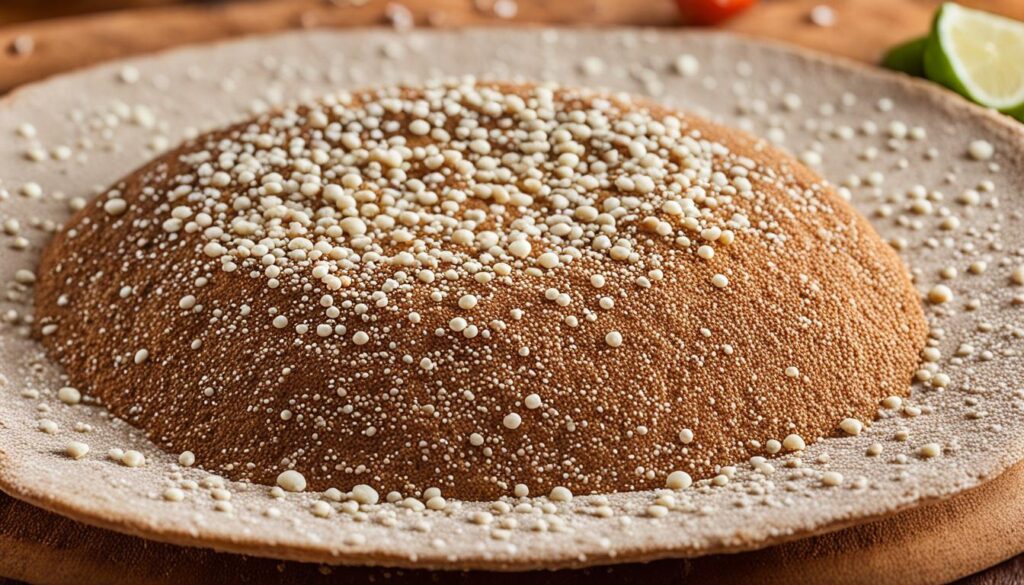
With its spongy texture and tangy flavor, Injera adds a delightful element to Ethiopian cuisine. Its slightly acidic taste cuts through the richness of stews and curries, providing a unique balance of flavors. It acts as a base for many dishes by soaking up the juices and spices, creating a harmonious blend of tastes.
Whether you’re enjoying a spicy lentil stew known as Misir Wot, or savoring the rich flavors of Doro Wat, a chicken stew, the sour taste of Injera complements these dishes beautifully. It adds complexity and depth to every bite, enhancing the overall dining experience.
Not only is Injera a delicious bread, but it also has practical uses in Ethiopian meals. Due to its large size, it can be used as a platter, with a variety of different dishes placed on top. This communal dining style, where everyone gathers around a large Injera-covered plate, adds to the cultural experience of Ethiopian cuisine.
So, the next time you indulge in Ethiopian food, make sure to savor the unique taste of Injera. Its sour tang and versatility make it an essential component of the Ethiopian dining tradition, adding an unmistakable flavor to every meal.
Meat, Vegetarian, and Vegan Delights
When it comes to Ethiopian cuisine, the options are abundant, catering to the diverse dietary preferences of meat lovers, vegetarians, and vegans alike. Whether you crave flavorful Ethiopian meat dishes, prefer vegetarian Ethiopian food, or opt for vegan options, there is something for everyone to indulge in.
Delicious Meat Dishes
If you’re a meat lover, Ethiopian cuisine is a paradise. From spicy Doro Wat, a chicken stew, to succulent Kitfo, seasoned raw minced beef, the Ethiopian meat dishes are sure to tantalize your taste buds. Each dish boasts a unique blend of spices and flavors, reflecting the rich culinary heritage of Ethiopia.
Vegetarian Temptations
Ethiopian cuisine offers a delectable range of vegetarian delights that will impress even the most discerning palates. Staples like Misir Wat, a spicy lentil stew, and Gomen, a flavorful collard greens dish, showcase the expertise of Ethiopian cooking in creating vegetarian dishes bursting with flavor.
Vibrant Vegan Offerings
Vegans rejoice! Ethiopian cuisine embraces plant-based ingredients and offers a myriad of options to satisfy your taste buds. Indulge in dishes like Atakilt Wat, a spiced cabbage and carrot stew, or Shiro, a smooth and creamy chickpea stew. These vegan delights are proof that Ethiopian cuisine excels at creating dishes that are both satisfying and full of flavor.
Flavorful Stews and Traditional Dishes
Ethiopian cuisine is renowned for its flavorful stews and rich variety of traditional dishes. These dishes are a true reflection of Ethiopian culture and culinary heritage. Let’s dive into some of the most popular Ethiopian stews and traditional dishes, known for their mouthwatering taste profiles.
One of the well-loved Ethiopian stews is Doro Wat. This spicy chicken stew is a staple in Ethiopian cuisine and is often enjoyed during festive occasions. The tender chicken, simmered in a vibrant blend of spices and flavored with a unique spice called berbere, creates a taste sensation that is both bold and aromatic. Doro Wat is traditionally served with injera, a spongy and sour flatbread, which perfectly complements the richness of the stew.
Traditional Ethiopian Dishes
Another popular traditional Ethiopian dish is Tibs, which consists of seasoned and sautéed meat, usually beef or lamb. Tibs showcases the vibrant flavors of Ethiopia, with its tender meat, caramelized onions, and aromatic spices. The dish is often enjoyed with injera or bread, providing a satisfying and flavorful dining experience.
Ethiopian cuisine also offers a variety of vegetarian and vegan options. One such dish is Misir Wat, a spicy red lentil stew. The combination of tender lentils, onions, and rich spices creates a hearty and satisfying dish that is beloved by both vegetarians and meat-eaters alike.
As you explore the diverse world of Ethiopian stews and traditional dishes, you will be delighted by the explosion of flavors, the use of aromatic spices, and the unique taste profiles that make Ethiopian cuisine truly special.
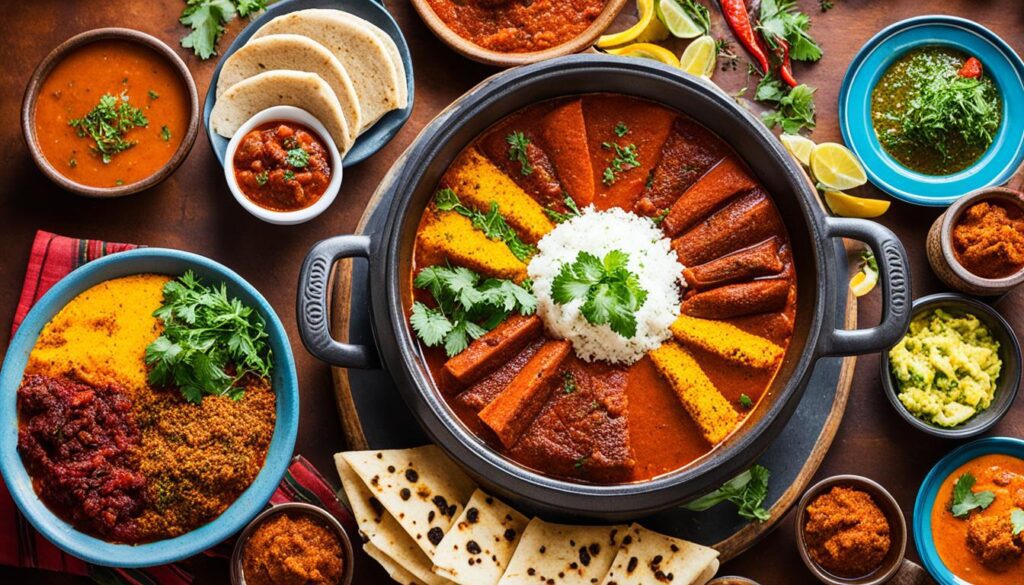
The Heat Factor – Ethiopian Spices and Heat Levels
Ethiopian cuisine is a tantalizing blend of flavors, and one of the standout elements is the heat it brings to the table. The secret behind the spicy Ethiopian food lies in the remarkable array of aromatic spices used, which add depth, complexity, and a fiery kick to the dishes.
When it comes to Ethiopian spices, there is a wide variety that contributes to the heat levels of the cuisine. Some of the prominent spices include:
- Berbere: This vibrant and aromatic spice blend is a staple in Ethiopian cooking. It is made from a combination of chili peppers, garlic, ginger, fenugreek, and other spices. Berbere lends a rich, smoky flavor and packs a spicy punch.
- Mitmita: Another popular spice blend, Mitmita, is known for its intense heat. It consists of dry chili peppers, cardamom, cloves, and other spices. Mitmita adds a fiery kick and a hint of earthiness to Ethiopian dishes.
- Paprika: While not as hot as Berbere or Mitmita, paprika still contributes to the spice factor in Ethiopian cuisine. It adds a vibrant red color and a mild, smoky sweetness to the dishes.
The heat levels in Ethiopian dishes can vary from mildly spicy to tongue-tinglingly hot, depending on the combination and amount of spices used. It’s important to note that spiciness is subjective, and what may be considered mild for some could be fiery for others. So, if you enjoy spicy food, be prepared to embrace the heat and savor the bold flavors of Ethiopian cuisine.
Whether you’re indulging in a hearty Doro Wat stew or savoring the flavors of Kitfo, the heat factor adds an exciting dimension to the overall taste experience. The spices not only provide a delightful sensory journey but also enhance the flavors of the ingredients, creating a harmonious balance in each dish.
So, if you’re a spice enthusiast or want to venture into the world of spicy Ethiopian food, be prepared to tantalize your taste buds with the captivating heat levels and aromatic flavors that Ethiopian cuisine has to offer.
Conclusion
In conclusion, Ethiopian food offers a unique and flavorful culinary experience. With its perfect blend of spices, flavors, and traditional cooking techniques, Ethiopian cuisine captivates the taste buds and takes you on a journey of vibrant and delicious flavors. Whether you are a meat lover or follow a vegetarian or vegan lifestyle, Ethiopian cuisine has something to offer everyone.
From the aromatic spices that create a symphony of flavors to the sour tang of Injera, the staple bread of Ethiopian cuisine, every bite brings a burst of taste that is both comforting and exciting. The flavorful stews, such as Doro Wat and Tibs, showcase the rich heritage and culture of Ethiopia, leaving a lasting impression on your palate.
If you’re curious about what Ethiopian food tastes like, we encourage you to explore the diverse dishes and indulge in this culinary adventure. Experience the heat and spice that Ethiopian spices bring to the table and savor the intricacies of each mouthwatering bite. Ethiopian food is a true celebration of flavor, tradition, and community, inviting you to embrace a whole new world of gastronomic delight.

